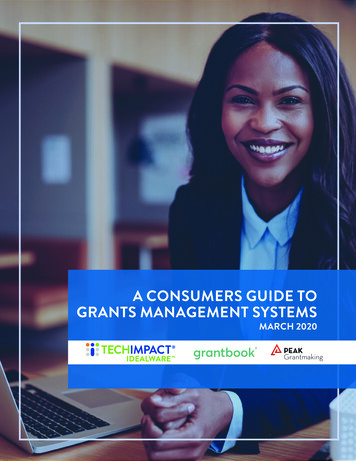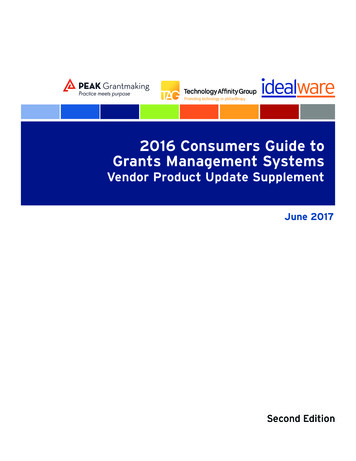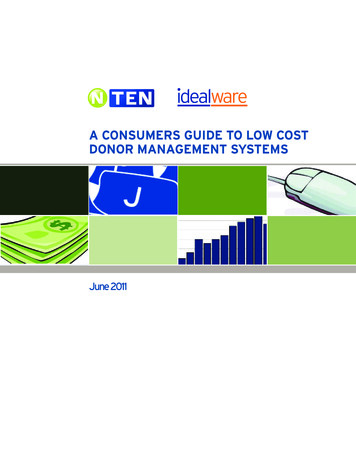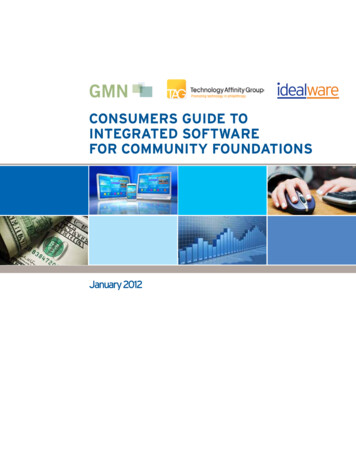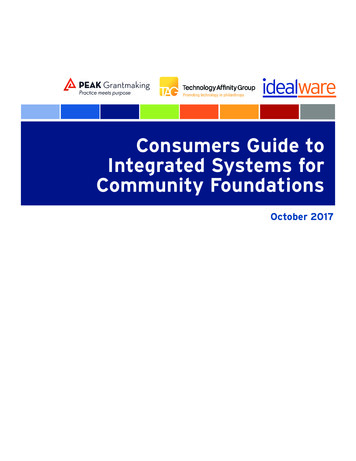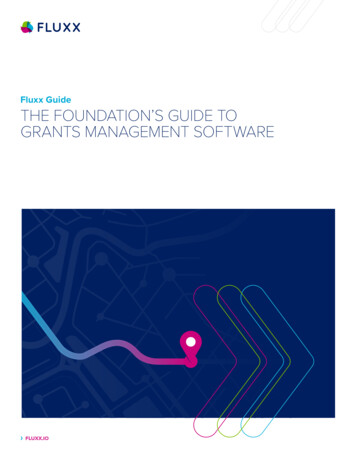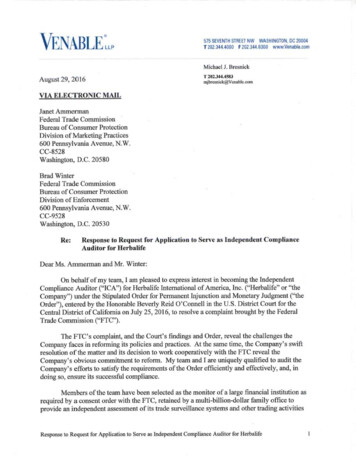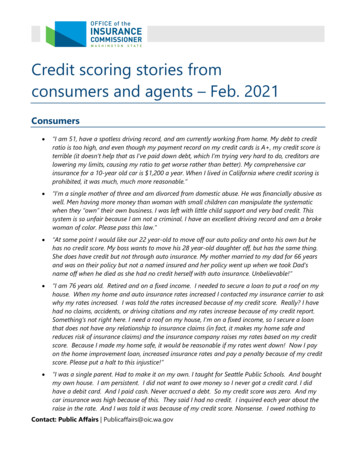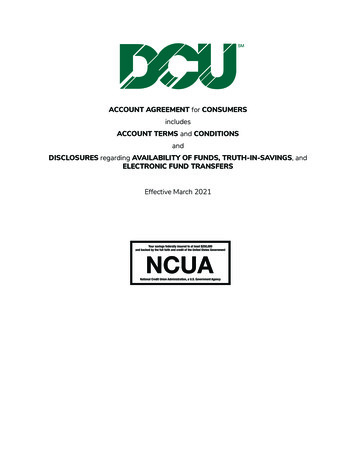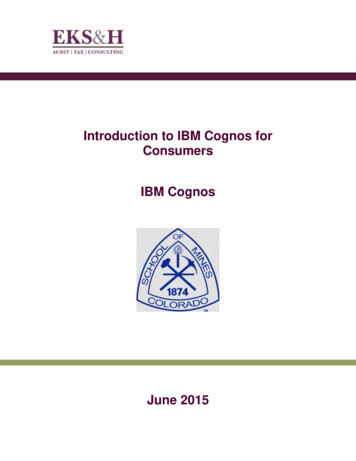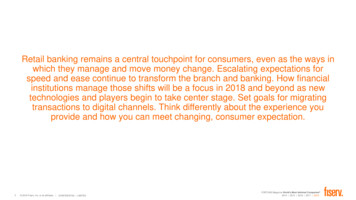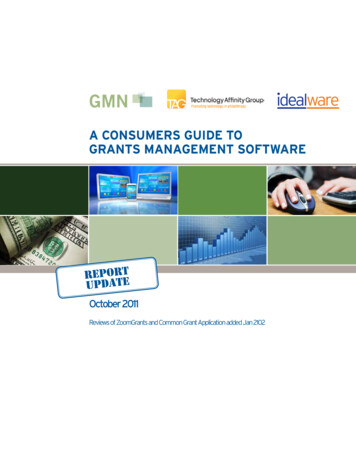
Transcription
A Consumers Guide toGrants Management SoftwareReportUpdateOctober 2011Reviews of ZoomGrants and Common Grant Application added Jan 2102
AuthorsJay Leslie, IdealwareLaura Quinn, IdealwareChris Bernard, IdealwareMany thanks to the organizations who supported this researchThe Grants Managers NetworkThe William and Flora Hewlett FoundationThe Charles Stewart Mott FoundationThe Technology Affinity GroupAnd to the experts who contributed their timeJoseph Behaylo, Open Society FoundationsIgnacio Estrada, Gordon and Betty Moore FoundationJonathan Goldberg, Surdna FoundationLisa Pool, Technology Affinity GroupMartin Schneiderman, Information Age AssociatesRebecca Van Sickle, The Atlantic PhilanthropiesPAGE2A Consumers Guide to Grants Management Software October 2011
ContentsExecutive Summary.4Considering Grants Management Systems.6Introduction.7Do You Need a Grants Management System?.9What Types of Systems Are Available?. 10What Do Grants Management Systems Do?.12What Do These Systems Cost?.22What Packages Are Available?.23Comparing the Systems. 30Comparison Chart.31How to Decide. 35Reviews of the Grants Management Systems.37Altum Easygrants. 38Altum proposalCENTRAL. 44Bromelkamp Akoya.net. 50Bromelkamp First Pearl. 56Closerware GrantMaker. 62Dulles Technology Partners WebGrants. 68Foundant Grant Lifecyle Manager.74FusionLabs GrantedGE.80Good Done Great Grant Management System. 86Grantium G3. 92GrantStream GrantRight . 98JK Group.104MicroEdge GIFTS . .110MicroEdge GIFTS Online. 116NPower Foundation Grant Manager. 122Oceanpeak Common Grant Application. 128PhilanTech PhilanTrack. 134SmartSimple GMS for Private Foundations . .140Solpath Fluxx.146WESTAF GrantsOnline . 152WizeHive Grant Manager.158ZoomGrants.164Appendices. 170Appendix A: Research Methodology. 171Appendix B: How We Evaluated the Systems. 172About the Report Partners.183PAGE3A Consumers Guide to Grants Management Software October 2011
Executive SummaryGrants management software helps grantmakerssave time, make their processes more effective andtransparent, and can even transform the way they dobusiness. The options in grant management systemsare growing every year, and there are currently moresolid systems than ever before.This expansion of the market is great for grantsmanagers, but the array of choices can make it complicated to decide what system makes sense for anygiven organization. This report explores the systemsavailable to help private foundations accept andreview applications and track grants throughout theirlife cycles, with detailed comparisons of 22 systems.There’s a huge varietyof grants managementsystems, ranging frombasic options at only afew thousand dollars ayear to robust solutionsfor large foundationsstarting at 100,000 ormore.Community foundations differ from private foundations in several important areas, and are thereforenot included in this report—we also have a report ongrants management software for community foundations that we’ll release soon after this one.What Systems Are Available?There’s a huge variety of grants management systems,ranging from options for small foundations at onlyPAGE4a few thousand dollars a year, specialty options forniches like arts grantmaking or medical researchfoundations, and robust, completely configurablesolutions for large foundations starting at 100,000 ormore.Low cost for simple needsMore functionality isn’t necessarily better. If youhave only a small grants program, a straightforwardsystem with a lower price tag could provide exactly thesupport you need. Consider Bromelkamp’sAkoya.net, Closerware GrantMaker,Foundant Grant Lifecycle Manager, MicroEdgeGIFTS Online, Oceanpeak’s Common GrantApplication, WizeHive Grant Manager orZoomGrants.Flexible relationship managementIf you are hoping to track not just the basic detailsof a grant, but complex custom tracking informationabout applications and relationships, consider thegrowing number of systems geared to support thisneed with customizable options and strong supportfor relationship management, such as BromelkampAkoya.net, Bromelkamp First Pearl, Good DoneGreat Grant Management System, MicroEdgeGIFTS, MicroEdge GIFTS Online, NPowerFoundation Grant Manager, SmartSimple GMSfor Private Foundations or Solpath Fluxx.Complex online data collection needsIf your core priority in a grants management systemis to collect complex application and grantee progressreport data online, a number of systems provideboth strong online support and useful general grantsmanagement functionality. Consider CyberGrants,Good Done Great Grant Management System,JK Group, PhilanTech PhilanTrack or NPowerFoundation Grant Manager.Complex application review needsSome systems provide very little functionality to support complex review processes, while others providecomplex scoring mechanisms, online forms to allowA Consumers Guide to Grants Management Software October 2011
outside reviewers, and even specialized functionalitygeared toward reviewing arts projects or medicalresearch applications. If review functionality is a corepriority, consider WESTAF GrantsOnline , DullesTechnology Partners WebGrants, GrantStreamGrantRight or Altum proposalCENTRAL.branching in online forms and robust budgetingfacility, have become far more common. The grantsmanagement system marketplace is becoming morevibrant, with healthy competition creating bettersystems for both small and large grantmakers.Strong all-around functionalityfor the large foundationIf you need all of the above—and are willing to payfor it—large “enterprise” systems provide strongfunctionality and customization for a larger pricetag. Consider Altum Easygrants, Grantium G3,FusionLabs GrantedGE or MicroEdge GIFTS.The number of vendorsoffering tools hasgreatly expanded,providing many moreoptions for smallerfoundations ataffordable costs.What’s Changed?We released the first edition of our Consumers Guideto Grants Management Systems in 2008, and sincethen the field of systems has evolved substantially.The number of vendors offering tools has greatlyexpanded, providing many more options for smallerfoundations at affordable costs. Online hostedsystems are also becoming the norm. While a fewtraditional installed systems remain available, allthe vendors in this report offer an online hostedoption. These hosted systems can be compelling tograntmakers—they allow program staff to login to thesystem from anywhere with internet access, and tendto provide better support for online applications andonline grantee communications.On the higher end, systems are adding compellingfeatures. Far more systems offer customization peruser—for instance, to show a “dashboard” of thetasks a user is likely to want to take on, or to providedifferent interfaces for different types of roles. Asan example, a grants manager might see an interfacethat allows sophisticated data management, whilea program officer might see one that’s pared downand easier-to-use. More advanced functionality, likePAGE5Comparing the SystemsHow do all these packages compare? It’s impossible tosay in a few quick paragraphs, but this report providesboth a high-level look at the systems and a closer lookat the details behind them. Quick paragraph blurbsdescribe the core strengths and weaknesses of eachsystem, and a comparison chart (starting on page 30)shows how they stack up across a set of 17 differentcriteria. Finally, the reviews of the systems provide adetailed, six-page summary of each system that showshow it addresses more than 125 different criteria.The grants management software marketplace hasnever had a better set of options to support effectiveand efficient grantmaking, and this report helps grantmakers understand how all these options compare.A Consumers Guide to Grants Management Software October 2011
Considering GrantsManagement Systems
IntroductionGrantmaking programs are complicated to manage.Even the relatively small programs can involve tracking dozens of applications, reviewers, requirementsand payments. But grants management software applications can help by saving grantmakers time, makingtheir processes more effective and transparent, andeven transforming the way they do business.We’ll take a look at whatgrants managementsystems do, andcompare the strengthsand weakness of thepackages availablefor grantmakers.Grantmakers’ choices are growing each year, and thesystems available to them range in complexity andprice. Small packages can support straightforwardonline application, review and progress reportingprocesses for less than 3,000 a year, while sophisticated, highly customizable systems might costupward of 200,000.How do you choose the right system for your needs?This report is a good place to start—we’ve done alot of the work for you. We’ll explore the availableoptions for accepting and reviewing applicationsand tracking grants throughout their life cycles, takea look at what grants management systems do, andcompare the strengths and weakness of the packagesPAGE7available for United States-based foundations. Thenwe’ll recommend packages that might work for yourorganization based on your specific needs.This report focuses on systems that help privatefoundations manage their grantmaking process throughthe entire grants lifecycle, including payment tracking.Community foundations differ from private foundationsin several important areas, and are therefore notincluded in this report—we also have a report ongrants management software for community foundations that we’ll release soon after this one.Note that there’s another kind of grants managementsystem entirely—one designed to help the recipientsof grants rather than grantmakers. These systems helpnonprofits manage proposal submissions and grantsthey’ve received, and confusingly, are also known asgrants management systems. They are not includedin this report.What’s Changed Since theLast Report?We released the first edition of our Consumers Guide toGrants Management Systems in 2008, and since then, thefield of systems has evolved substantially. The numberof vendors offering tools has greatly expanded,providing many more options for smaller foundationsat affordable costs.Online hosted systems are also becoming the norm.While a few traditional installed systems remainavailable, all the vendors in this report offer anonline hosted option. These hosted systems can becompelling to grantmakers—they allow program staffto login to the system from anywhere with internetaccess, and tend to provide better support for onlineapplications and online grantee communications.A Consumers Guide to Grants Management Software October 2011
On the higher end, systems are adding compellingfeatures. Far more systems offer customization peruser—for instance, to show a “dashboard” of thetasks a user is likely to want to take on, or to providedifferent interfaces for different types of roles. Asan example, a grants manager might see an interfacethat allows sophisticated data management, whilea program officer might see one that’s pared downand easier-to-use. More advanced functionality, likebranching in online forms and robust budgetingfacility, has become far more common.All of this is good news for grants managers, but itcan make it even more complicated to decide whatsystem makes sense for you. Don’t assume that asystem provides the best mix of features and price foryour needs just because a number of other people areusing it.PAGE8More advancedfunctionality, likebranching in onlineforms and robustbudgeting facility,has become far morecommon.A Consumers Guide to Grants Management Software October 2011
Do You Need a Grants ManagementSystem?If your processes are complex enough that you’rewondering whether a grants management systemmight be helpful, it’s probably worth taking a lookat the available packages. Generally speaking, grantsmanagement processes can be complicated. Evengrantmakers who give just a dozen or so grants a yearmight find a system useful—especially if they involvemultiple people in the review process, pay grantsIf you find your grantscan’t easily be trackedon a single Excelworksheet, you’lllikely find a packagedsystem helpful.in more than a single payment, require progressreports from grantees, or want to look at reports thatsummarize information about their grantmaking inaggregate.PAGE9Another key benefit of a packaged system, evenfor a small foundation, is the ability to collect dataonline—for example, grant applications or granteeprogress reports. If you’re considering shifting yourprocesses online, a grants management system canprovide both online and grant-tracking functionality ina single package.As a rule of thumb, if you find your grants can’t easilybe tracked on a single Excel worksheet, a packagedsystem is worth considering. You should also lookat the available packaged options if you’re debatingbuilding something yourself, such as a MicrosoftAccess database to track grants, or web forms toaccept online applications. Custom-built functionalityis almost always a bigger long-term investment, bothto build and support, than organizations expect. Itshould be a last resort when it’s clear nothing on themarket will meet your needs.With a few recent additions to the market that costless than 4,000 per year, there are more lower-costoptions than there ever have been before. For mostorganizations that make more than a handful ofgrants per year, they’re worth a look.A Consumers Guide to Grants Management Software October 2011
What Types of Systems Are Available?As you start to consider your options, think throughwhat types of systems might work for you before considering specific systems: Hosted Online or Installed,Integrated with Back-Office Services, Specialized forCommunity Foundations, or Custom-Built.It makes sense to thinkthrough what typesof packages mightwork for you beforeconsidering specificsystems.Hosted Online SystemsA growing number of grants management systemsare hosted entirely online, accessible through webbrowsers. In this model, sometimes called Softwareas-a-Service (SaaS), you pay a software vendor toprovide online access, and the software—along withall your grants data—is stored on the vendor’s servers.The benefits are that you don’t have to purchase anyhardware, the vendor handles software updates anddata backups, and your staff can access the systemfrom anywhere there’s an internet connection.But recent well-publicized security breaches involvingonline services have led some to question this kind ofsystem. The truth is, it can be quite secure—in fact,many banks and hospitals with far greater securityneeds rely on similar models. Security issues are notlimited to SaaS platforms; similar breaches have ocPAGE10curred with systems installed on site at organizationaldata centers behind company firewalls.The online systems currently available typically offerstrong support for online data collection, includingonline applications, review processes and progressreports. They range from straightforward, inexpensivepackages that cost less than 3,000 per year all theway up to very sophisticated, customized systemsfor 200,000 per year or more.Installed SystemsA more traditional option, these systems are purchased up front and installed onto your network andyour staff ’s computers. Many of these systems onlyrun on the Microsoft Windows operating system, soif your organization uses Mac or Linux machines, youmay have a difficult time finding one that’s compatible. With this model, you’re responsible for softwareupdates and data backups.The available installed system
PAGE 2 A Consumers Guide to Grants Management Software October 2011 Authors Jay Leslie, Idealware Laura Quinn, Idealware Chris Bernard, Idealware Many thanks to the organization
